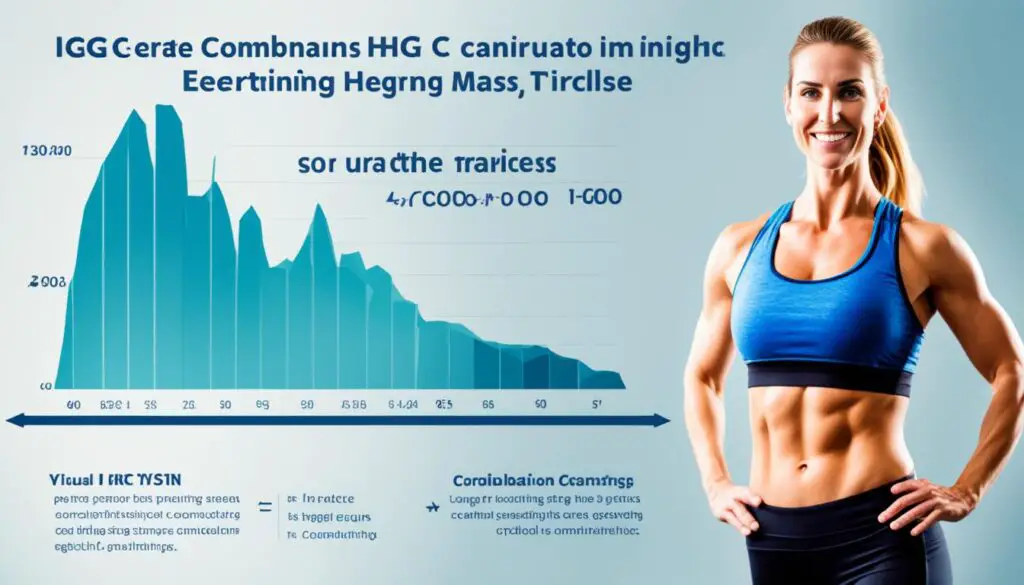Did you know that weight fluctuations are common during the HCG maintenance phase? This critical period, designed to stabilize weight loss and establish new dietary habits, can often be marked by unexpected changes in weight. While it is normal to experience fluctuations within a 2 lb window, several factors can contribute to more significant variations. Understanding these factors and implementing strategies to manage weight changes is essential for a successful HCG maintenance phase.
Key Takeaways:
- Weight fluctuations during the HCG maintenance phase are common and expected.
- Factors like incorrect LDW weight, food choices, exercise, and calorie intake can contribute to significant weight changes.
- Gradually increasing calorie intake, reintroducing foods, regular exercise, and daily weigh-ins can help manage weight fluctuations effectively.
- Implementing a Steak Day when necessary can address significant weight gain during the maintenance phase.
- Long-term weight management requires lifestyle changes, including a balanced diet, regular physical activity, and ongoing mindfulness about food choices and portion sizes.
Understanding LDW and Stabilization
During the maintenance phase of the HCG diet, individuals aim to stabilize their weight around LDW (Last Day Weight or Last Injection Weight). LDW is not the weight on the first day of Phase 3. Instead, it represents the weight individuals strive to maintain after completing the low-calorie diet and HCG injections.
After the final dose of HCG, some individuals may continue to experience weight loss during the last 72 hours of the low-calorie diet. However, this weight is often regained quickly upon starting Phase 3. As individuals transition into the maintenance phase, it is common to observe temporary weight increases before stabilizing around LDW.
Stabilizing under LDW weight is not a common goal and should not be overly focused on. During the maintenance phase, it is important to understand and accept the natural fluctuations that can occur. Weight fluctuations are part of the body’s adjustment process and should not be a cause for alarm.
Why Stabilizing Under LDW Weight is Uncommon?
The goal of the maintenance phase is not to continue losing weight but rather to establish new dietary habits and stabilize the weight loss achieved during the previous phases. While some individuals may naturally stabilize slightly below their LDW weight, significant under-stabilization is not commonly observed.
Attempting to rigidly achieve a weight lower than LDW can lead to excessive stress and anxiety, potentially undermining the positive results achieved during the HCG diet program. It is important to focus on long-term weight management and overall well-being rather than obsessing over a specific number on the scale. Gradual and sustainable weight maintenance should be the primary objective.
Understanding the concept of LDW and embracing the natural fluctuations that may occur during the maintenance phase is key to a successful and sustainable weight maintenance journey. By setting realistic expectations and focusing on long-term habits rather than short-term fluctuations, individuals can maintain the benefits of the HCG diet program without undue stress or pressure.
Impact of Food Choices

The food choices during the HCG maintenance phase play a significant role in weight fluctuations. While some foods are allowed, others should be avoided to ensure successful weight management. It is essential to be mindful of the impact of certain foods, especially fruits and melba/grissini, which may lead to weight fluctuations.
Fruits and melba/grissini are generally not recommended during the weight loss phase (Phase 2) of the HCG diet. However, in the maintenance phase (Phase 3), these foods can be reintroduced in moderation. It is crucial to understand that consuming these foods can sometimes contribute to weight fluctuations.
To minimize the impact of fruits and melba/grissini on weight, portion control and overall calorie intake are key. Following the recommended food guidelines and being mindful of the quantities consumed can help manage weight fluctuations more effectively.
Impact of Fruits
Fruits are a source of natural sugars and can slightly affect blood sugar levels. While fruits offer essential vitamins, minerals, and fiber, their impact on weight fluctuations may vary depending on individual metabolism and portion sizes.
“Consuming a variety of fruits can provide valuable nutrients, but it’s important to be conscious of the portion sizes and their potential impact on weight fluctuations.”
Choosing fruits with lower glycemic loads, such as berries and citrus fruits, can be beneficial in managing weight during the maintenance phase. These fruits generally have lower sugar content and may have a lesser impact on weight fluctuations compared to higher-sugar fruits like bananas or grapes.
Impact of Melba/Grissini
Melba toast and grissini are popular options for adding variety to meals while maintaining the HCG protocol. These crispy snacks are typically low in calories and carbohydrates, making them suitable for the maintenance phase.
However, it is essential to be cautious about the portions consumed. Excessive intake of melba toast or grissini can lead to an increased calorie intake, potentially contributing to weight fluctuations.
“Incorporating melba toast or grissini into your meals can be a way to enjoy different textures and flavors, but paying attention to portion control is vital for managing weight fluctuations effectively.”
When including melba toast or grissini in your diet, ensure that you are mindful of the recommended portion sizes to keep calorie intake in check. This can help prevent any significant weight changes during the maintenance phase.
Striking a balance with the amount of fruits and melba/grissini consumed during the HCG maintenance phase is crucial for managing weight fluctuations. Adhering to the recommended food guidelines and being mindful of portion sizes can support successful weight management during this phase of the HCG diet.
Effect of Exercise
https://www.youtube.com/watch?v=WRtJXdAvpwA
Exercise plays a crucial role during the HCG maintenance phase. Engaging in regular physical activity not only supports weight management but also promotes overall health and well-being. However, it’s important to understand the impact of exercise on weight fluctuations during this phase.
When individuals incorporate exercise into their routine, they may notice temporary weight gain, even when following the protocol correctly. This is a normal occurrence and should not be a cause for concern. The body’s response to exercise, such as water retention and muscle repair, can contribute to these temporary fluctuations in weight.
Continuing to exercise regularly during the maintenance phase is vital for managing weight changes and maintaining a healthy body composition. Regular physical activity helps burn calories, build muscle, and improve overall fitness. It also aids in stabilizing weight fluctuations and preventing rapid weight regain.
By combining exercise with a balanced diet and other effective strategies, individuals can effectively manage their weight during the HCG maintenance phase. It is recommended to consult with a healthcare professional or fitness expert to create an exercise plan that aligns with individual goals and capabilities.
Gradual Calorie Increase

The HCG maintenance phase is a critical period for stabilizing weight loss and establishing new dietary habits. During this phase, managing weight fluctuations becomes crucial, and one effective approach is through a gradual calorie increase.
It is recommended to start with a calorie increase of around 200 kcal per day during the HCG maintenance phase. This gradual approach allows the body to adjust to the higher calorie intake without causing significant weight fluctuations. Rather than abruptly increasing calorie intake, which can confuse the body and lead to more noticeable weight changes, a gradual increase helps maintain stability.
To determine the general optimum amount of calories, a common calculation is to multiply your weight by 13. This calculation provides a rough estimate of the number of calories you should aim for during the maintenance phase. However, it’s essential to listen to your body’s needs and adjust accordingly.
The Benefits of Gradual Calorie Increase
Implementing a gradual calorie increase offers several benefits during the HCG maintenance phase:
- Minimizing Weight Fluctuations: By gradually increasing calorie intake, you allow your body to adapt and stabilize without experiencing drastic weight fluctuations. This approach promotes a more balanced and sustainable weight management journey.
- Preventing Metabolic Shock: Sudden increases in calorie intake can shock the body’s metabolism, potentially leading to rapid weight gain. Gradual calorie increases help the body adjust and avoid sudden metabolic shifts.
- Maintaining Hormonal Balance: Calorie increases help maintain hormonal balance, ensuring a smooth transition from the low-calorie phase to maintaining weight. This balance supports overall well-being and reduces the risk of hormonal imbalances that may impact weight stability.
By gradually increasing calorie intake during the HCG maintenance phase, individuals can effectively manage weight fluctuations and establish healthier dietary patterns for long-term success.
Reintroduction of Foods
After completing the HCG maintenance phase, it is time to reintroduce sugars and starches into your diet. However, it is important to proceed with caution and make dietary adjustments gradually to prevent rapid weight regain. This gradual food reintroduction allows your body to adapt and helps you maintain a stable weight.
When reintroducing sugars and starches, it is advisable to start with low-carb and low-fat options. This helps you manage weight changes more effectively while still enjoying some of your favorite foods. Begin with small portions and gradually increase the intake over time.
Monitoring your weight during this period is crucial. Pay attention to how your body responds to different food choices and adjust accordingly. If you notice any significant weight changes, consider making further adjustments to your diet or portion sizes.
Sample Food Reintroduction Plan:
Here is a sample plan to guide you through the reintroduction process:
| Week | Food Group | Suggested Options |
|---|---|---|
| 1 | Fruits | Apples, berries, citrus fruits |
| 2 | Starchy Vegetables | Sweet potatoes, butternut squash, peas |
| 3 | Grains | Quinoa, brown rice, whole wheat bread |
| 4 | Sweeteners | Raw honey, maple syrup, stevia |
Remember, finding a balance and practicing moderation is key. Adjusting your food choices gradually and paying attention to your body’s response will help you maintain a stable weight while reintroducing sugars and starches into your diet.
Importance of Exercise

Exercise plays a crucial role in maintaining weight loss after the HCG maintenance phase. Engaging in regular physical activity is highly recommended to support weight management and promote overall health.
During the HCG maintenance phase, incorporating both cardio and resistance exercises into your routine can be beneficial. Cardio exercises, such as jogging, swimming, or cycling, help burn calories and improve cardiovascular fitness. Resistance exercises, such as weightlifting or bodyweight exercises, help build and maintain lean muscle mass, which can increase metabolism and aid in weight management.
A minimum of 75 minutes of vigorous exercise or 150 minutes of moderate exercise per week is suggested by experts. This can be divided into multiple sessions throughout the week to make it more manageable. It’s important to choose activities that you enjoy and that fit your fitness level.
Exercise not only helps burn calories but also contributes to weight stability by improving overall fitness. Regular physical activity increases energy expenditure, which can help prevent weight regain and promote weight maintenance. Creating a sustainable exercise routine during the maintenance phase is crucial for long-term weight management.
The Benefits of Exercise in Weight Management
Regular exercise offers numerous benefits when it comes to weight management:
- Calorie Burning: Exercise helps burn calories, creating an energy deficit that contributes to weight loss and weight maintenance.
- Muscle Building: Resistance exercises help build and maintain lean muscle mass, which increases metabolism and supports weight management.
- Appetite Regulation: Exercise can help regulate appetite and reduce cravings, making it easier to maintain a healthy diet.
- Improvement in Body Composition: Regular exercise can lead to a decrease in body fat percentage and an increase in muscle mass, improving overall body composition.
- Mood Enhancement: Exercise releases endorphins, which can improve mood and reduce stress, making it easier to stick to healthy habits.
- Improved Fitness: Exercise improves cardiovascular health, endurance, and strength, enhancing overall fitness and well-being.
Implementing an exercise routine during the HCG maintenance phase can greatly contribute to long-term weight management and overall health. It’s essential to find activities that you enjoy and make exercise a regular part of your lifestyle.
Tips for Incorporating Exercise during the HCG Maintenance Phase
- Choose Activities You Enjoy: Find physical activities that you find enjoyable and that fit your fitness level. This will increase the likelihood of sticking to your exercise routine.
- Start Slowly: If you’re new to exercise or have been sedentary for a while, start with low-impact activities and gradually increase intensity and duration over time.
- Mix It Up: Include a combination of cardio and resistance exercises in your routine to reap the benefits of both. This can keep your workouts interesting and target different aspects of fitness.
- Schedule Your Workouts: Treat exercise as an important appointment by scheduling it into your daily or weekly calendar. This can help you prioritize physical activity and ensure consistency.
- Stay Hydrated: Drink plenty of water before, during, and after your workouts to stay hydrated and support optimal performance.
- Listen to Your Body: Pay attention to how your body feels during exercise and adjust intensity or duration accordingly. Rest and recover when needed to avoid overexertion and injury.
- Track Your Progress: Keep a record of your workouts, noting duration, intensity, and any improvements you notice. This can help motivate you and track your progress over time.
By implementing an exercise routine during the HCG maintenance phase and adopting healthy lifestyle habits, you can maintain your weight loss success and enjoy long-term weight management.
Daily Weigh-In

Monitoring your weight on a daily basis is an essential practice during the HCG maintenance phase. By weighing yourself before breakfast each morning, you gain valuable insights into any significant weight changes. This daily weigh-in routine allows you to stay proactive in managing your weight and making necessary adjustments to your diet and exercise routine to ensure you remain within your desired weight range.
Weighing yourself daily provides you with the data needed to take action. If you notice that your weight exceeds two pounds above your HCG weight, it is recommended to institute a Steak Day. This intervention helps reset your body and bring your weight back within the desired range.
“Daily weigh-ins provide valuable information to maintain weight stability and make necessary adjustments to your diet and exercise routine.”
Keeping track of your weight fluctuations during the maintenance phase is crucial for success. By monitoring your weight daily, you can catch any deviations early on and make the necessary course corrections to keep your weight in check. This daily practice empowers you to take control of your weight management journey and ensures that you remain on track to maintain the results achieved during the HCG diet program.
Key Benefits of Daily Weigh-Ins:
- Early detection of weight fluctuations
- Time for prompt corrective action
- Ability to maintain weight stability
- Keeping motivation and accountability
Implementing a Steak Day

Instituting a Steak Day during the HCG maintenance phase is a valuable strategy for managing weight fluctuations and bringing the weight back within the desired range. A Steak Day involves specific steps that can help reset the body and support weight stability.
Skip Breakfast and Lunch
Steak Day on HCG maintenance phase requires skipping breakfast and lunch. By restricting your calorie intake during these meals, you create a calorie deficit that can contribute to weight loss or stabilization. Intermittent fasting during this time allows your digestive system to reset and prepares your body for the upcoming meal.
8 oz to 14 oz Steak for Dinner
For dinner, consume only an 8 oz to 14 oz steak. This high-protein food choice helps satisfy hunger and provides essential nutrients. Opt for lean cuts of steak, such as sirloin or filet mignon, to minimize unnecessary fats. Grilling or broiling the steak is a healthy cooking method that retains the natural flavors without adding excessive calories.
Raw Apple or Tomato as Accompaniment
Pair your steak with a raw apple or tomato for dinner. These fruit options offer added fiber and nutrients without substantially increasing calorie intake. The natural sweetness of the apple or the refreshing taste of the tomato complements the savory flavor of the steak, creating a satisfying and balanced meal.
The management of weight fluctuations with Steak Day is a proven technique on the HCG maintenance phase. By following the steps outlined above, you can effectively implement a Steak Day and help bring your weight back within the desired range.
Remember that individual weight fluctuations may vary, and it’s important to consult with your healthcare professional or follow the guidance of the HCG diet protocol to ensure a successful and safe weight management journey.
Benefits of Implementing a Steak Day
| Benefits | Explanation |
|---|---|
| Weight Reset | A Steak Day can help reset your body’s weight and bring it back within the desired range, reducing significant weight gain. |
| Calorie Restriction | Skipping breakfast and lunch and consuming only an 8 oz to 14 oz steak with a raw apple or tomato for dinner creates a calorie deficit, promoting weight loss or stabilization. |
| High Protein Intake | The steak provides a high protein intake, which helps satisfy hunger and supports muscle maintenance and repair. |
| Dietary Balance | Pairing the steak with a raw apple or tomato adds a source of fiber, vitamins, and minerals, creating a balanced meal. |
Post-Maintenance Phase

After completing the maintenance phase of the HCG diet, it is important to transition back to a regular eating pattern gradually. This post-maintenance phase allows individuals to reintroduce sugars and starches into their diet in small amounts, ensuring the body can adjust and minimize any weight fluctuations.
During this phase, it is crucial to continue daily weigh-ins to monitor weight changes closely. If the weight exceeds the desired range, implementing a Steak Day can be an effective strategy to bring the weight back within the target range.
Maintaining mindfulness and moderation with food choices is key to overall good health during this phase. By making thoughtful decisions about the types and quantities of sugars and starches reintroduced, individuals can ensure a stable weight while still enjoying a varied diet.
Long-Term Lifestyle Changes
Beyond the post-maintenance phase of the HCG diet, it is crucial to adopt long-term lifestyle changes for sustained weight management. These changes include incorporating regular exercise into daily routines.
Regular exercise plays a vital role in long-term weight management by burning calories, building muscle, and improving overall fitness. It is recommended to engage in a minimum of 150 minutes of moderate exercise or 75 minutes of vigorous exercise per week.
By implementing an exercise program custom-tailored to individual preferences and fitness levels, individuals can optimize weight management efforts and improve overall well-being.
It is also important to maintain ongoing mindfulness about food choices and portion sizes, even beyond the HCG diet program. By incorporating a balanced diet consisting of a variety of nutrient-dense foods, individuals can support their weight management journey and promote optimal health.
| Benefits of Long-Term Lifestyle Changes | Strategies for Success |
|---|---|
| 1. Sustained weight loss | 1. Set realistic goals |
| 2. Improved overall health and well-being | 2. Prioritize regular physical activity |
| 3. Increased energy levels | 3. Monitor daily calorie intake |
| 4. Reduced risk of chronic diseases | 4. Seek support from a healthcare professional |
Conclusion
Managing weight fluctuations during the HCG maintenance phase can be challenging, but with the right strategies, individuals can successfully navigate this period. By understanding the factors that contribute to weight changes and implementing proven techniques, such as gradually increasing calorie intake, reintroducing foods, engaging in regular exercise, monitoring weight through daily weigh-ins, and utilizing Steak Days when necessary, individuals can effectively manage their weight during this phase.
However, it’s important to remember that long-term weight management requires more than just the maintenance phase. It necessitates lifestyle changes that include maintaining a balanced diet, engaging in regular physical activity, and practicing mindfulness when making food choices and controlling portion sizes. By incorporating these strategies into daily life, individuals can not only maintain their weight loss success achieved through the HCG diet program but also achieve long-term weight management and overall well-being.
Remember, weight fluctuations are a natural part of the maintenance phase, but by staying dedicated and following these proven strategies, individuals can overcome the challenges and successfully manage their weight over the long term.
FAQ
What are the common weight fluctuations during the HCG maintenance phase?
It is normal to experience weight fluctuations within a 2 lb window during the HCG maintenance phase. However, factors such as incorrect LDW weight, food choices, exercise, and calorie intake can contribute to more significant weight changes.
What is LDW, and how does it relate to weight fluctuations?
LDW stands for Last Day Weight or Last Injection Weight. It is the weight individuals aim to stabilize around during the HCG maintenance phase. Understanding LDW helps manage weight fluctuations effectively.
How do food choices impact weight fluctuations on the HCG maintenance phase?
Food choices, particularly the reintroduction of fruits and melba/grissini, can sometimes lead to weight fluctuations. It is important to be mindful of portion sizes and overall calorie intake to minimize their impact on weight.
Does exercise affect weight fluctuations during the HCG maintenance phase?
Yes, exercise can contribute to temporary weight gain due to factors like water retention and muscle repair. However, regular physical activity is crucial for weight management and overall health during the maintenance phase.
How can I manage weight fluctuations with a gradual calorie increase during the HCG maintenance phase?
Gradually increasing calorie intake by around 200 kcal per day and finding the optimum amount (often calculated by multiplying your weight by 13) helps the body adjust and minimize weight fluctuations.
How should I reintroduce sugars and starches into my diet during the HCG maintenance phase?
It is important to reintroduce sugars and starches gradually starting with low-carb and low-fat options. Monitoring weight changes and adjusting food choices based on weight can help manage weight fluctuations effectively.
How does exercise play a role in managing weight during the HCG maintenance phase?
Regular physical activity, such as cardio and resistance exercises, supports weight management and overall well-being during and after the HCG maintenance phase. A minimum of 75 minutes of vigorous exercise or 150 minutes of moderate exercise per week is recommended.
Why is daily weigh-in important during the HCG maintenance phase?
Daily weigh-ins allow individuals to monitor significant weight changes. If the weight exceeds two pounds above the HCG weight, implementing a Steak Day can help manage weight fluctuations effectively.
What is a Steak Day, and how can it help with weight fluctuations on the HCG maintenance phase?
A Steak Day involves skipping breakfast and lunch and consuming only an 8 oz to 14 oz steak and a raw apple or tomato for dinner. This calorie restriction helps reset the body and bring weight back within the desired range.
What should I do after completing the HCG maintenance phase?
After completing the maintenance phase, gradually start adding sugars and starches back into your diet in small amounts. Daily weigh-ins should continue, and if weight exceeds the desired range, implementing Steak Days can help manage weight fluctuations.
What are the long-term strategies for managing weight after the HCG maintenance phase?
Long-term weight management requires lifestyle changes, including a balanced diet, regular physical activity, and ongoing mindfulness about food choices and portion sizes. Incorporating exercise and maintaining moderation with food choices are key.




